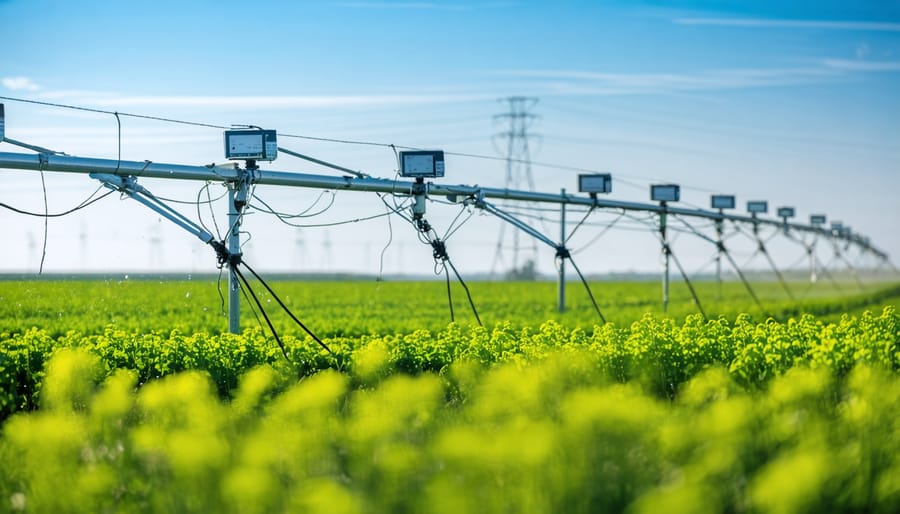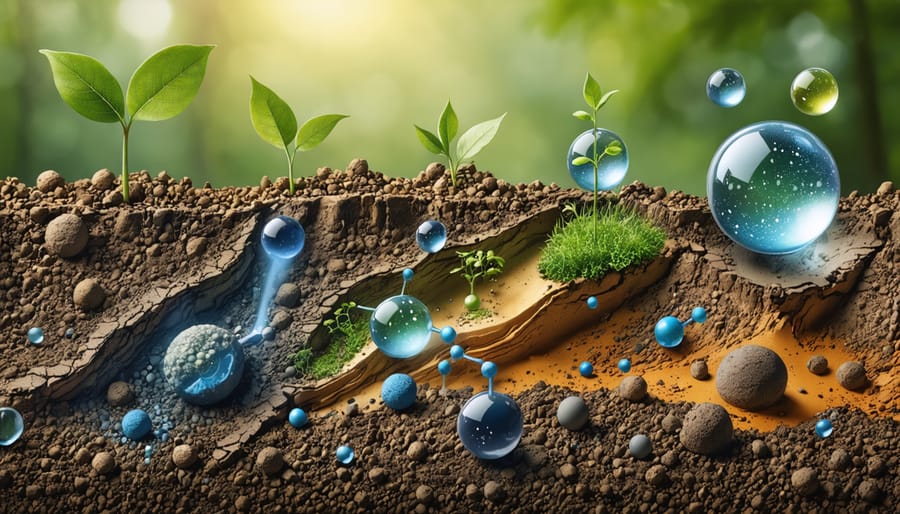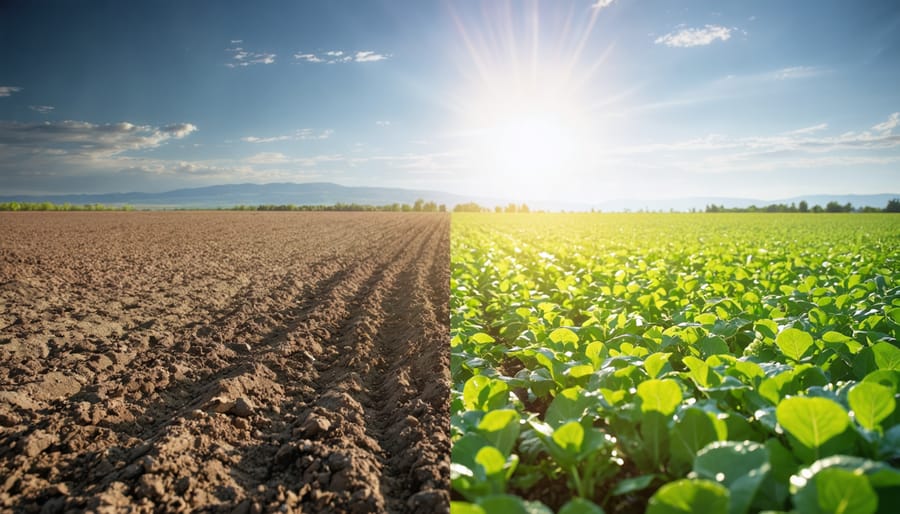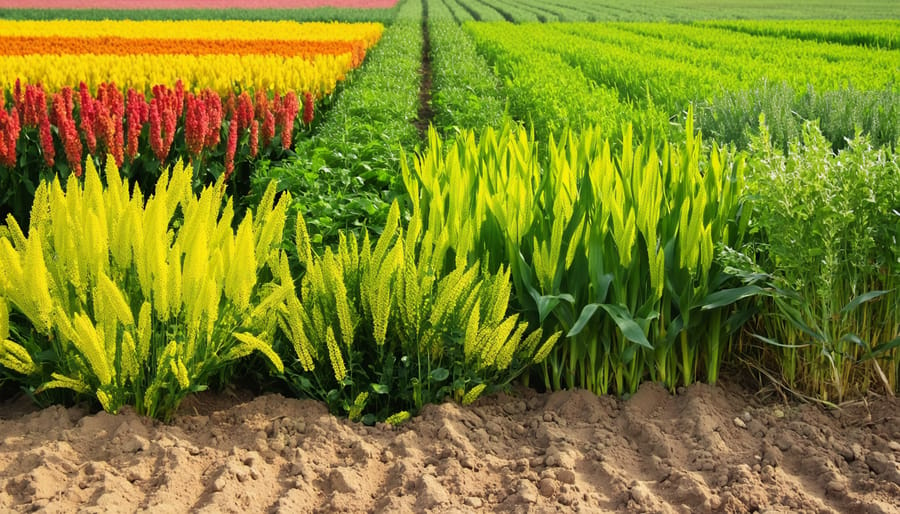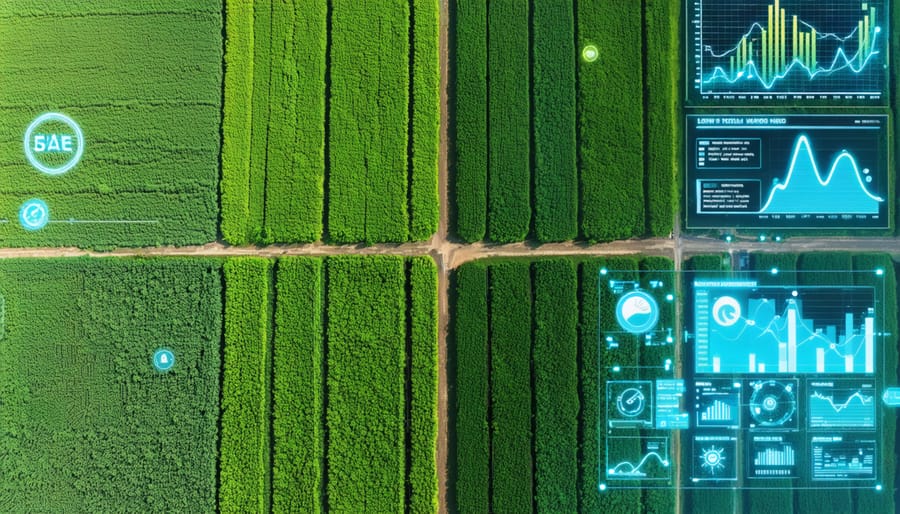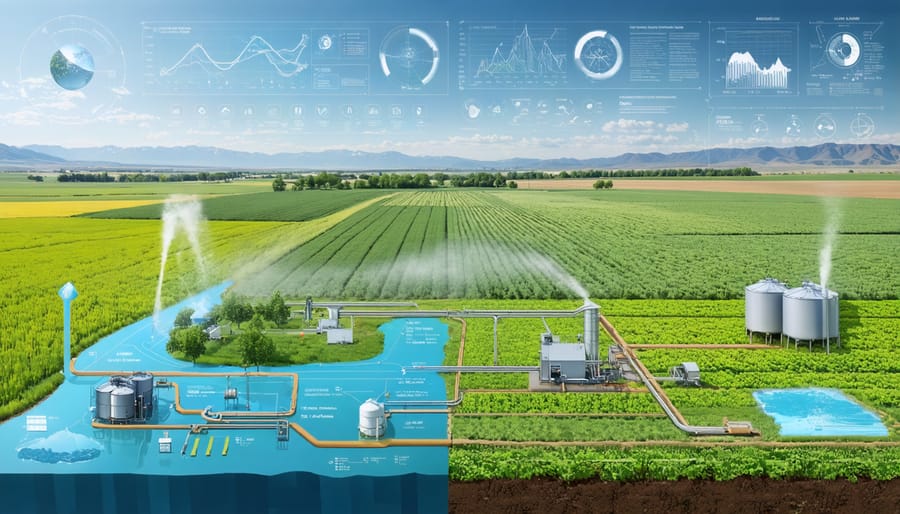Transform your farm’s sustainability by installing a professional-grade potable rainwater harvesting system that meets Alberta’s strict agricultural standards. Modern collection systems, when properly designed, can harvest rainwater effectively while ensuring drinking-water quality through multi-stage filtration and UV treatment.
Canadian farmers currently save an average of 45,000 litres annually through properly implemented rainwater collection, significantly reducing groundwater dependency and irrigation costs. With Alberta’s average annual rainfall of 482mm, a 100-square-metre roof area can capture approximately 48,200 litres of pristine water yearly – enough to support diverse organic farming operations during critical growing periods.
Recent advances in first-flush diverters, ceramic filters, and food-grade storage systems have made potable rainwater harvesting increasingly viable for organic certification. These systems not only meet Health Canada’s drinking water guidelines but also align with sustainable agriculture practices, providing chemical-free water that supports soil health and crop vitality.
For Alberta farmers transitioning to regenerative agriculture, implementing a certified potable rainwater system represents a strategic investment in both environmental stewardship and operational resilience. The technology is proven, the regulations are clear, and the benefits to organic farming operations are immediate and measurable.
Why Potable Rainwater Systems Matter for Your Farm
Meeting Alberta’s Water Quality Standards
In Alberta, turning rainwater into potable water requires strict adherence to provincial standards and the Alberta Building Code. Your system must meet the requirements outlined in the Environmental Public Health Indoor Air Quality Manual, which includes specific guidelines for collection, filtration, and treatment processes.
Key requirements include installing a first-flush diverter, implementing a multi-stage filtration system, and using NSF-certified components. Your water must be tested regularly for bacteria, heavy metals, and other contaminants by an accredited laboratory. Testing frequency typically ranges from monthly to quarterly, depending on your system’s size and usage.
Working with a certified water treatment specialist is essential to ensure your system meets all local health regulations. They can help you develop a water safety plan and maintain proper documentation of testing results and system maintenance.
Remember that municipalities may have additional requirements beyond provincial standards. Before installation, connect with your local health authority to understand specific permits and inspections needed for your area. Many regions offer support and resources to help farmers implement compliant systems while maintaining organic certification standards.
Cost Savings and Water Security
Implementing a potable rainwater harvesting system can significantly reduce water-related expenses while building long-term resilience against drought conditions. Alberta farmers utilizing proven water collection strategies report annual savings between $2,000 and $5,000 on water costs, with some experiencing even greater benefits during dry seasons.
Beyond immediate cost savings, these systems provide invaluable water security during periods of drought. A properly designed 50,000-litre system can sustain essential farm operations for up to three months without rainfall, ensuring continuous access to clean water for livestock and crop irrigation. This independence from municipal water sources is particularly valuable in remote areas where connection costs to municipal systems can exceed $15,000.
Many farmers have found that combining rainwater harvesting with efficient irrigation practices reduces their overall water consumption by 30-40%. The initial investment in a comprehensive system typically pays for itself within 3-5 years through reduced water bills and increased crop resilience during dry spells. Additionally, government rebates and agricultural sustainability programs can offset installation costs by up to 30%.
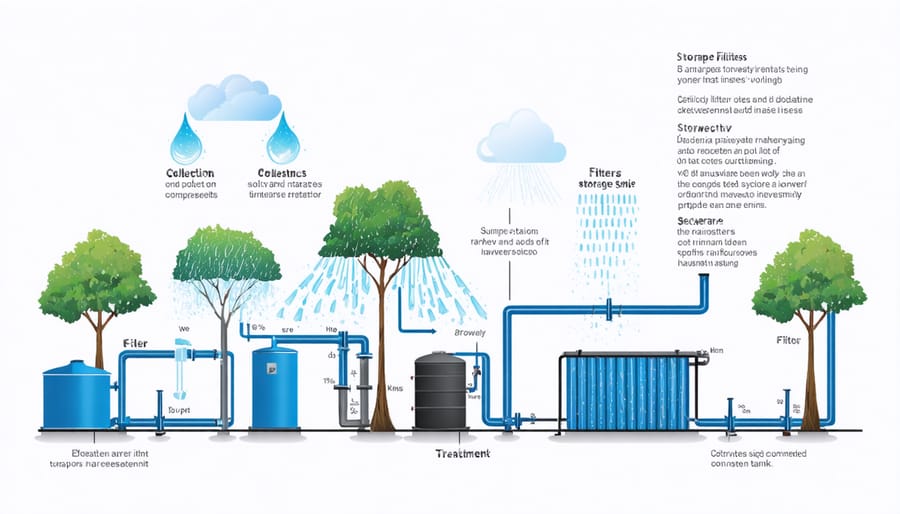
Essential Components of a Safe Rainwater System
Collection Surfaces and First Flush Diverters
Your collection surface – typically your roof – plays a crucial role in determining water quality and system efficiency. Here in Alberta, metal roofing is ideal for rainwater harvesting, providing a clean, smooth surface that minimizes contamination. If you’re using asphalt shingles, ensure they’re well-maintained and free from moss or algae growth.
Before setting up your collection system, thoroughly clean your roof and gutters. Install gutter guards to prevent leaves and larger debris from entering your system. Position your downspouts to maximize water collection while ensuring proper drainage away from your building’s foundation.
First flush diverters are essential components that redirect the initial flow of rainwater, which typically contains the highest concentration of contaminants. For our Alberta climate, we recommend installing a diverter that discards the first 2 litres per square metre of roof area. This helps manage spring runoff and ensures cleaner water enters your storage system.
Local farmer Mike Thompson from Red Deer shares, “Installing a first flush diverter was a game-changer for our system. The water quality improved significantly, and maintenance became much easier.” Consider installing multiple diverters if you have a large collection area, positioning them strategically to manage water flow effectively.
Remember to inspect and clean your collection surfaces and diverters regularly, especially after winter and during fall when leaves are falling. This maintenance routine will help ensure optimal system performance and water quality.
Filtration and Purification Methods
For organic farms, implementing effective filtration and purification methods is crucial to ensure safe, potable rainwater. Many Alberta farmers have found success with natural water purification methods that align with organic certification requirements.
First-flush diverters are essential components that redirect the initial rainfall, which typically contains the highest concentration of contaminants. These systems automatically separate the first few millimetres of rainfall, allowing cleaner water to enter the storage system.
Leaf screens and debris filters serve as the primary line of defense, preventing larger particles from entering the system. For optimal results, install multiple filtration stages, starting with 5mm mesh screens and progressing to finer filters.
Sand and gravel filtration systems have proven particularly effective for organic operations. These natural filtering methods use layers of differently sized materials to trap particles while allowing beneficial minerals to remain in the water. Many Alberta farmers layer their systems with 30cm of coarse gravel, followed by 40cm of sand, and topped with 20cm of activated charcoal.
UV sterilization offers a chemical-free approach to eliminating harmful bacteria and pathogens. Solar-powered UV systems are becoming increasingly popular among organic farmers, providing an environmentally friendly solution that maintains water purity without compromising organic certification.
For those seeking additional purification, ceramic filters infused with silver ions provide excellent bacterial removal while meeting organic standards. These filters typically last 6-12 months and can be cleaned and reused multiple times.
Regular maintenance is crucial for any filtration system. Schedule monthly inspections of all components and clean or replace filters as needed. During winter months, ensure proper insulation to prevent freezing and maintain system effectiveness throughout Alberta’s cold season.
Remember to test your water quality quarterly using approved testing facilities to ensure your filtration system continues to meet safety standards for potable water use.

Installation and Maintenance Best Practices
Seasonal Maintenance Schedule
Regular maintenance of your rainwater harvesting system is crucial for ensuring safe drinking water throughout Alberta’s diverse seasons. As part of effective drought resilience strategies, follow these seasonal tasks to keep your system operating efficiently.
Spring (March-May):
– Clean gutters and downspouts of winter debris
– Inspect roof catchment area for damage
– Clean first-flush diverters
– Test water quality after winter
– Check filters and UV systems
Summer (June-August):
– Monitor mosquito screens
– Clean pre-filters monthly
– Inspect tank levels regularly
– Check for algae growth
– Maintain landscaping around ground-level components
Fall (September-November):
– Clear gutters of fallen leaves
– Insulate exposed pipes
– Check heating systems for freeze protection
– Clean tank sediment
– Test backup systems
Winter (December-February):
– Monitor heat tape operation
– Clear snow from critical components
– Check tank insulation
– Maintain minimum water levels
– Test water quality monthly
For optimal performance, document all maintenance activities and keep detailed records of water quality tests. Consider scheduling professional inspections annually, particularly before winter, to ensure your system remains compliant with local health regulations.
Water Quality Monitoring
Regular testing of your harvested rainwater is crucial for ensuring safe drinking water for your family and livestock. We recommend implementing comprehensive water quality monitoring systems that align with Alberta Health Services guidelines.
Test your water monthly for basic parameters like pH, turbidity, and bacterial presence. During spring runoff and after major storms, increase testing frequency to bi-weekly. Essential parameters to monitor include:
– Total coliform and E. coli (monthly)
– pH levels (monthly)
– Turbidity (monthly)
– Total dissolved solids (quarterly)
– Heavy metals (annually)
– Pesticides (annually, particularly during growing season)
Keep detailed records of all test results and system maintenance. Many local agricultural extension offices provide water testing services at reduced rates for farmers. Consider investing in basic testing equipment for routine monitoring between professional lab tests.
If you notice changes in water colour, taste, or odour, conduct immediate testing. Install automated monitoring systems with real-time alerts for critical parameters. These systems can help detect issues before they become serious problems, saving time and ensuring consistent water quality for your organic operation.
Remember to calibrate testing equipment regularly and replace testing supplies before their expiration dates. Building relationships with certified water testing laboratories in your area can provide valuable support for your monitoring program.
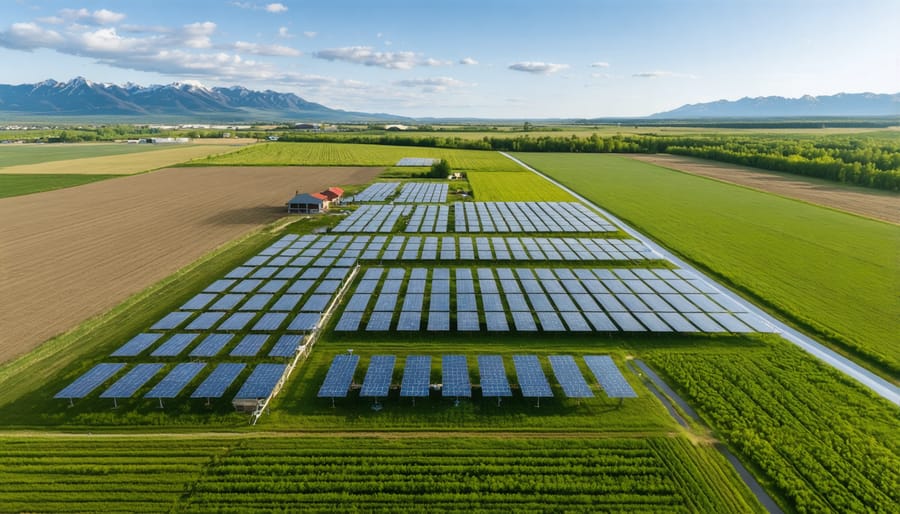
Real Success Stories: Alberta Farms
At Sunrise Organic Farm near Camrose, Sarah and Tom McKenzie transformed their 160-acre operation by implementing a comprehensive rainwater harvesting system in 2019. “We reduced our reliance on well water by 70% in the first year alone,” shares Sarah. Their system, which includes a 50,000-litre storage capacity, supplies water for their greenhouse operations and provides drinking water for their livestock after proper filtration and treatment.
In the Medicine Hat region, the Rodriguez Family Farm stands as another success story. Maria Rodriguez installed a multi-stage filtration system that collects rainwater from their 2,000-square-metre barn roof. “The system paid for itself within three years through reduced water hauling costs,” Maria explains. Their setup includes first-flush diverters, UV treatment, and regular water quality monitoring, meeting all Alberta Health Services requirements for potable water.
The Mountain View Collective, a community-supported agriculture project near Olds, demonstrates how multiple farms can benefit from shared resources. Five neighboring farms collaborated to create an interconnected rainwater harvesting network, complete with centralized treatment facilities. “By pooling our resources, we reduced individual installation costs by 40%,” notes James Chen, one of the participating farmers.
Perhaps the most innovative implementation comes from the Lakeside Organic Gardens near Lacombe. Owner Patricia Thompson designed a gravity-fed system that requires minimal energy input. “We collect roughly 900,000 litres annually, which covers 85% of our irrigation needs and all our household requirements,” Thompson reports. Their system includes advanced filtration, continuous monitoring, and backup power supplies for essential treatment components.
These success stories share common elements: careful planning, strict adherence to provincial regulations, and regular system maintenance. Each farm reported significant cost savings on water supply, improved crop resilience during dry periods, and enhanced sustainability credentials that resonated with their customers.
The Alberta Organic Producers Association has documented these implementations as model examples, noting that farms using properly maintained rainwater harvesting systems showed increased drought resilience and reduced operational costs by an average of 45% compared to traditional water sourcing methods.
Taking the first step toward implementing a rainwater harvesting system doesn’t have to be overwhelming. Start by conducting a site assessment of your property, measuring your annual rainfall, and calculating your water needs. Connect with your local Agricultural Services Board for guidance on permits and regulations specific to your county.
For Alberta farmers, the Environmental Farm Plan (EFP) program offers valuable resources and potential funding opportunities for sustainable water management projects. Contact your regional EFP technician to schedule a consultation and learn about available grants that could help offset installation costs.
Join local farming networks and organizations like the Alberta Farm Fresh Producers Association, where you can connect with other farmers who have successfully implemented rainwater harvesting systems. Many are willing to share their experiences and offer practical advice based on real-world implementation.
Consider reaching out to certified rainwater system installers in your area – the Canada Green Building Council maintains a directory of qualified professionals. Your local Conservation Authority can provide additional resources and may offer workshops on system maintenance and water quality testing.
Remember to start small and scale up as needed. Begin with a simple collection system for greenhouse irrigation or livestock watering, then expand based on your experience and needs. Document your journey and share your success with the farming community – your experience could help others make the transition to sustainable water management.
For immediate support, contact Alberta Agriculture and Forestry’s Ag-Info Centre, where specialists can answer questions about system design, water quality standards, and local regulations. Together, we can build a more sustainable future for Alberta’s agricultural community.



